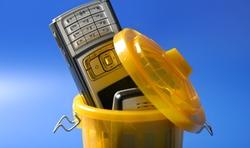One thing that bothers me about tablets is that they just aren't very durable. Will they soon become a throwaway product and part of the electronic waste problem? With three kids, I know all too well about durable (or not) technology. Cell phones have been the worst. None of my kids have dropped their phones in the ocean, like one of our neighbor's kid did, not once, but twice. They have dropped their phones in regular water (a foot bath and a gym potty), and all of their ear-buds regularly go through the washer and dryer cycles. One of my kids lost her phone for a couple of months. It turned up in one of her roller blades. It has been educational to see which phones hold up and which ones don't. We've tried LG, Pantech, Motorola, and Samsung phones. We've had pretty good luck with Samsung (Flight II and Galaxy S smart phones), and will probably continue to buy that brand. LGs and Motorolas have been OK. We won't be buying any more Pantechs. The cell phone sales model is quite enticing, because provider subsidies make it fun and easy to get into a given phone. You can also buy insurance, for a fixed fee or as a monthly charge, to offset the cost of replacement. Buying a new phone can be quite expensive because even cheapo texting-type slider phones can cost upwards of a couple hundred dollars. Add in the monthly fee, whether you use your phone or not, and you've got quite a financial commitment. If your cell phone stops working or you lose it, it's basically a throwaway.
We Have a Situation Developing
I think we might have a similar situation developing with tablets. Certainly, current tablets offer stunning performance that dazzle and bring a smile to the face of their proud owner. Tablets are also becoming fairly commonplace, with worldwide shipments topping 68 million units in 2011, according to IDC. The same study expected the number to exceed 106 million in 2012 and 198 million by 2016. For the modern mobile pro or even mobile kid, the cool features and bright screens make it easy to be sucked into a purchase. Obviously, tablets are selling. One big problem, in my mind, is that virtually all tablets require additional protection. While the Gorilla Glass is tough, it simply won't hold up to impact damage, whether from being dropped or from something hitting the surface. There are countless examples, all over the Web, of people shattering their screens. My brother-in-law showed me the armored iPad he uses at his company. It has a thick plastic rim around the outside with a clear plastic film on the front. The sleeve makes the iPad water-resistant and adds about ¾ inch to the thickness of the device. I actually liked the feel because I think my Transformer Prime, at about 3/8-inch thick, is definitely much less natural to grip. Repairs are another issue with tablets. Replacing a screen on a Transformer Prime costs about $130 in labor and anywhere from $85 to $185 in parts. That's a total of up to $315 to repair. The thing cost $499 new! If the tablet still works, in spite of a cracked screen, does it warrant getting it fixed? Most people would say no. What if it didn't work? Then, the tablet becomes a throwaway. At least there wouldn't be any monthly usage charges. How do readers think the throwaway mentality affects the mobile development community?
Related Links
Image: Mobile phone on the trash [BigStock] Image: Cracked Fortune [BigStock]



